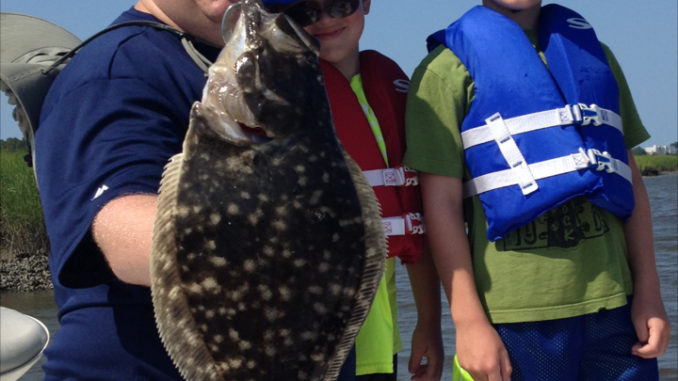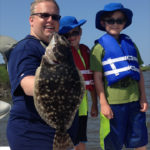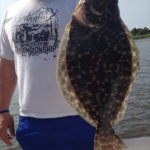
Inshore or on the reefs, Little River fishermen have plenty of flounder to catch.
In the middle of the summer, the Grand Strand’s public waterways fill up with just about every type of vessel imaginable, from kayaks and jet skis to the 200-foot gambling ships loaded with vacationers looking to hit the jackpot. Folks looking to take home the top fishing prize should troll their way to Little River’s flounder grounds, where a bona fide reward is lurking below the water’s surface.
For starters, the waters around Little River are extremely fertile with the influx of nutrients coming from the Waccamaw River through the longest man-made section of the ICW throughout its range. As the freshwater pumps into the estuary, it intercepts the saltwater coming in from Little River Inlet and neighboring Tubbs and Hog Inlets; it forms ideal nursery conditions for juvenile fish and crustaceans.
Depending on the tide and the Waccamaw’s flow, currents are pushing water and bait around in all different directions. Add docks, seawalls, rocks and creeks, and flounder are happy to spend their summer vacation in this paradise.
As long as the water temperature is in the 60s or above, Tom Cushman of Captain Cush’s Fishing Charters will be tempting flounder with a mud minnow or a Gulp swimming mullet.
“Little River is one of the best places around to catch flounder consistently, all summer long,” said Cushman. “We catch some real nice ones, too.”
Since flounder rely on their natural configurations to set up and ambush bait, the endless possibilities around Little River make it tough to choose where to start fishing. Cushman fishes a wide variety of places, from old docks along the ICW to the massive jetty rocks along the inlet.
“They are along sandy areas next to structure. One of the best places is around the rocks at the inlet. They pop up in good numbers at the jetties in July,” he said.
The tidal currents wash baitfish and shrimp in and out of the inlet on both sides of the tide. Flounder will set up motionless on the bottom along the base of the jetty rocks. Typically, flounder prefer to ambush bait in shallow water but will choose places adjacent to deep water for refuge — and that makes the inlet a prime ambush position.
David Cutler of Lowcountry Fishing Charters fishes the jetties all summer for flounder, and he said the jetty margins are not created equal — some places are better than others to find doormats.
“There are flounder set up on both sides of the rocks, but we catch more on the outside than on the inside. There are more snags on the inside,” said Cutler, who will cast up against the rocks and work his baits slowly down or just off the rocks, with one exception.
“On the inside of the jetties, just off the beach where Bird and Waites islands have the big sand flats, there are deep, washed-out holes right up in this shallower water that always hold a few doormats,” he said.
While the jetties provide great flounder action, the uniqueness of the Little River area provides much more opportunity for a steady bite where the jetties are nowhere in sight. Any area with structure and deep water close by offers flounder the opportunity to feed.
Cushman finds flounder around oyster beds in the main creeks and in areas along the ICW.
“From the last couple hours of the falling tide to the first two hours of the rising tide, they set up shop on the deep side of oyster bars in the creeks. When you find a good one that produces, you can almost always count on catching a few fish there on repeat trips,” said Cushman, who loves to fish the ICW for flounder because they are predictable — but in their own way.
“The flounder living in the ICW move more in schools. Some places produce better on moving water, and others produce better on slack current,” said Cushman, who will fish from the shallow fringe next to the marsh grass all the way to the edge of ledges that drop off into deeper water.
“Flounder are holding up next to the grass or along the edge of a current rip to ambush bait, and where you find one, there are always several in there.”
Cushman’s favorite places to catch flounder along the ICW are docks, which provide places for bait to hide and even better places for flounder to set up in ambush.
Fortunately for fisherman, flounder are not selective feeders. Any small fish, shrimp or tasty-looking creature will draw a strike, and flounder don’t nibble baits, either; they inhale and swallow things whole. The most-important rule for catching flounder is not the type of bait, but to put the bait in the right place — served right in front of their double-eyed face.
Cushman and Cutler will use finger mullet, mud minnows or any other small, live fish on either a Carolina rig or naked jighead. Their Carolina rigs will feature a small egg sinker or split shot about 18 to 24 inches above a No. 1 or 2 J-hook.
When the bait gets thick, Cutler choose artificials over natural baits.
“When using artificials, you will catch more flounder because there is so much bait available in summer they are more likely to eat something they haven’t seen,” said Cutler, who will use artificials that stand out but still look appetizing bouncing off the bottom; his favorites are Gulp swimming mullet or jerk shad in white or chartreuse.
DESTINATION INFORMATION
HOW TO GET THERE — Little River is at the northern end of the Grand Strand, straddling the North Carolina-South Carolina border. US 17 and SC 9 are primary routes to access the area, whose waters are easily accessible from two public boat ramps under the US 17 bridge over the ICW in Cherry Grove/North Myrtle Beach or the public boat ramp at Sunset Beach across the North Carolina line.
WHEN TO GO — Flounder begin moving into inshore waters late in the spring and will be available well into the fall. Anglers using summer techniques can enjoy good action between June and September.
BEST TECHNIQUES — Target flounder in water that’s between 8 inches and 5 feet deep; they are ambush feeders who will set up along the edge of structure waiting for the next meal to swim past. Choose bright colors in soft-plastic baits that imitate small minnows and shrimp or use live mud minnows, finger mullet, menhaden or shrimp on 1/4- to 1/2-ounce jigheads. A slow retrieve works well. Use light spinning tackle with as little weight as possible and small hooks no larger than No. 1. Fish a Carolina rig with 18 to 24 inches of 14- to 20-pound monofilament or fluorocarbon leader. Standard “J” hooks work, but Octopus-Circle or standard circle hooks. Fishing around nearshore reefs requires heavier rigs and tackle; a bucktail jig tipped with a Gulp jerk shad is a great combo tied to braided line.
FISHING INFO/GUIDES — Tom Cushsman, Capt. Cush’s Fishing Charters, 843-997-5850, www.captcush.com; David Cutler, Lowcountry Fishing Charters, 843-222-7433, www.lowcountryfishingcharters.com. See also Guides and Charters in Classifieds.
ACCOMMODATIONS — Myrtle Beach Area Convention and Visitors Bureau, www.mbchamber.com; South Carolina Association of Visitors Bureaus, www.discoversouthcarolina.com.
MAPS — Navionics, 800-848-5896, www.navionics.com; Waterproof Charts (Near shore No. 98), 800-423-9026, www.waterproofcharts.com; Maps Unique, 910-458-9923, www.mapsunique.com; SeaLake Fishing Guides, 800-411-0185, www.sealakeusa.com.





